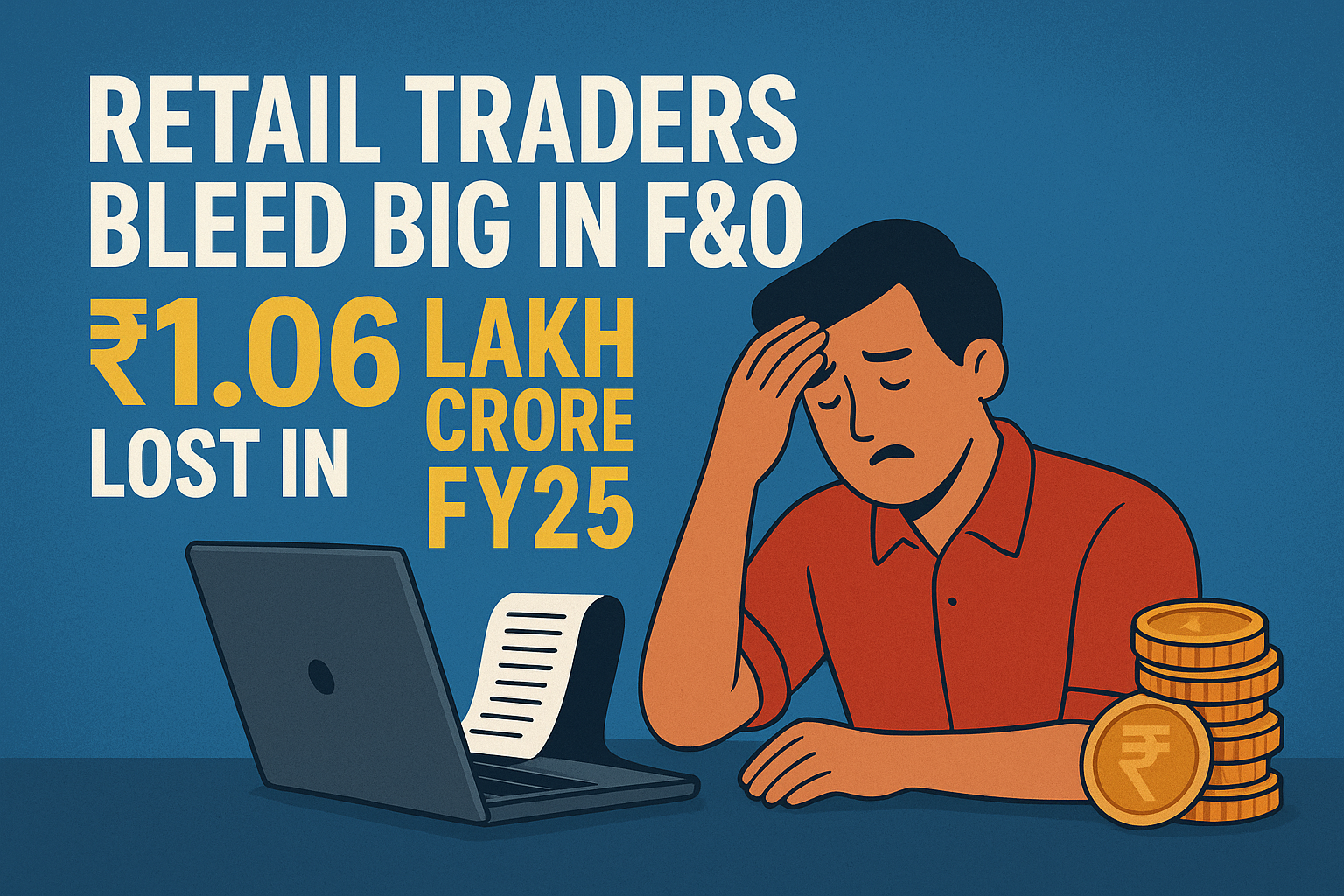
Have you seen that jaw-dropping headline ₹1.06 lakh crore lost by retail investors in F&O during FY 25? That’s not a typo. It’s 41% more than the previous year. Crazy, right? Almost 91% of individual traders were in the red. Let’s break this down like I’d tell my friend clear, casually, and packed with insights.
1. Retail F&O losses FY25 , The numbers that won’t quit
- SEBI’s big study shows retail net losses hit ₹1.05–1.06 lakh crore in FY 25, up from ₹74,812 crore in FY 24 a sharp 41% jump.
- Roughly 91% of retail traders lost money, an almost unchanged figure from previous years.
- Losses aggregated over FY 22 to FY 24 were even steeper: about ₹1.8 lakh crore, with an average loss of ₹2 lakh per trader.
2. Why are losses piling up like this?
Leverage Gambles Gone Wild
F&O gives you superpowers with leverage, but with great power comes great risk—small capital can evaporate in a heartbeat.
Emotional Overdrive & FOMO
Too many traders rely on TikTok tips, not strategy. Everyone wants those quick gains. Big trouble.
Speed Trap vs. Algo Giants
Retail traders can’t compete with high-frequency players. SEBI even banned Jane Street over suspected manipulation and froze over $550 million, spotlighting how David often loses to Goliath here.
Transaction Costs Crunch
Even if you break even on trading, fees and brokerage can turn that green into red—put a dent in profits real quick.
3. Is the trading herd thinning? Not really.
- Retail participation dropped 20% YoY, from around 61 lakh to 43 lakh during FY25—but it’s still 24% higher than two years ago. These new traders keep walking into the storm.
- Turnover trimmed too: Premium turnover is down 11% YoY, but index options turnover remains significantly elevated versus FY23.
4. Regulator to the rescue? SEBI’s moves, and their limits
SEBI didn’t just watch this unfold—they acted. In 2024–25, new rules included:
- Fewer contract expiries (bye bye weekly bets),
- Bigger lot sizes (raising the entry bar),
- Transparent risk disclosures, and
- Real-time oversight of positions and margins.
Still, numbers show these measures slowed but didn’t stop the retail bleed.
5. What can you—and I—take away from this?
Let’s talk practicality—like I’m explaining to a buddy over chai:
- F&O is speculation, not investment. Treat it like a casino if you’re not armed with knowledge.
- Long-term wins come from discipline, not adrenaline. Think equity SIPs, mutual funds, index ETFs.
- If you trade F&O, don’t do it blind. Use tested strategies, set strict stop-losses, and never chase losses emotionally.
- Beware the influencers. Most online tips are not gold—not even 7% of traders are profitable over years.
Understand tax & compliance, too—it’s not just trading, it’s your life and taxes in play.
| Category | Details (SEO-Optimized) |
|---|---|
| Total Retail Losses in F&O Trading India FY25 | ₹1.06 Lakh Crore (41% higher vs FY24 losses of ₹74,800 Cr) |
| Percentage of Retail Investors Losing in Derivatives | Over 91% of retail traders ended FY25 with losses |
| 3-Year Cumulative Retail F&O Losses | ₹1.81 Lakh Crore lost by retail investors (FY23–FY25) |
| Retail Participation Trend | Active F&O traders dropped 20% YoY in FY25 but still up 24% from FY23 |
| Why Retail Investors Lose Money in F&O | • Leverage trap (small capital, high exposure) • Lack of trading discipline & strategy • Over-reliance on social media tips • Speed disadvantage vs institutional players • Psychological biases (overconfidence, revenge trading) |
| SEBI F&O Regulations FY24–FY25 | • Restrictions on weekly expiry contracts • Larger minimum lot sizes • Mandatory broker risk disclosures • Real-time risk monitoring systems |
| Impact of SEBI Regulations on F&O Market | • Retail premium turnover dropped by 11% • Speculation remains high despite tighter rules |
| India in Global Derivatives Market | India = 78% of global equity options trading volume (2023–24), led by retail investors |
| Safer Alternatives for Retail Investors | • Long-term equity investing • Mutual funds & index ETFs • Disciplined trading with StopLoss/Target • Back-tested trading strategies, not emotions |
Final Take: Time to Rethink Retail Trading in F&O
The staggering ₹1.06 lakh crore retail losses in F&O trading in FY25 highlight a brutal truth — the derivatives market in India is not designed for everyone. Despite India emerging as the global hotspot for equity options trading, retail investors continue to bleed due to lack of strategy, capital, and discipline.
For most individuals, Futures and Options trading has proven to be more of a gamble than a wealth-creation tool. The path forward is clear: treat F&O as high-risk speculation, not as an investment avenue. Instead, building wealth through long-term equity investing, mutual funds, or index ETFs remains the safer and smarter choice.
As SEBI regulations on F&O trading get tighter and awareness grows, retail traders must shift their mindset from chasing quick profits to adopting a disciplined, strategy-driven approach. The Indian stock market is a powerful engine for wealth creation — but only when investors respect the risks and invest wisely.




